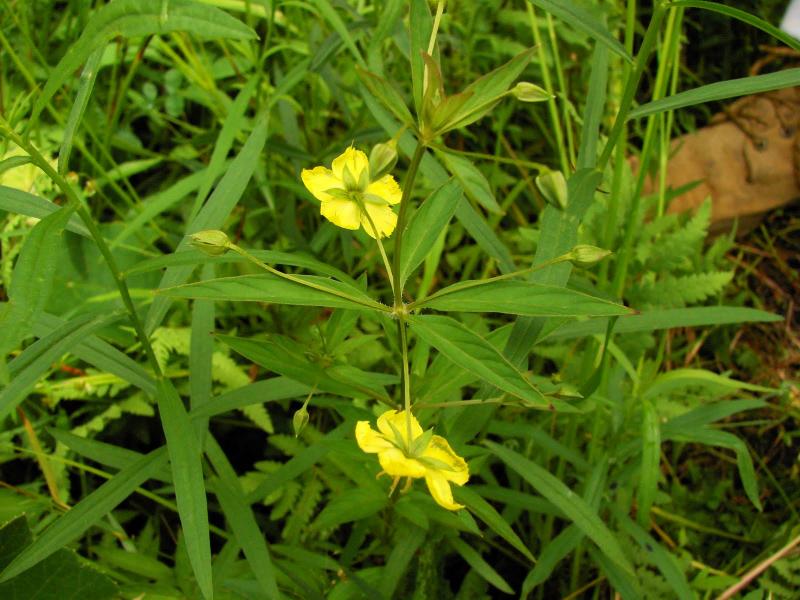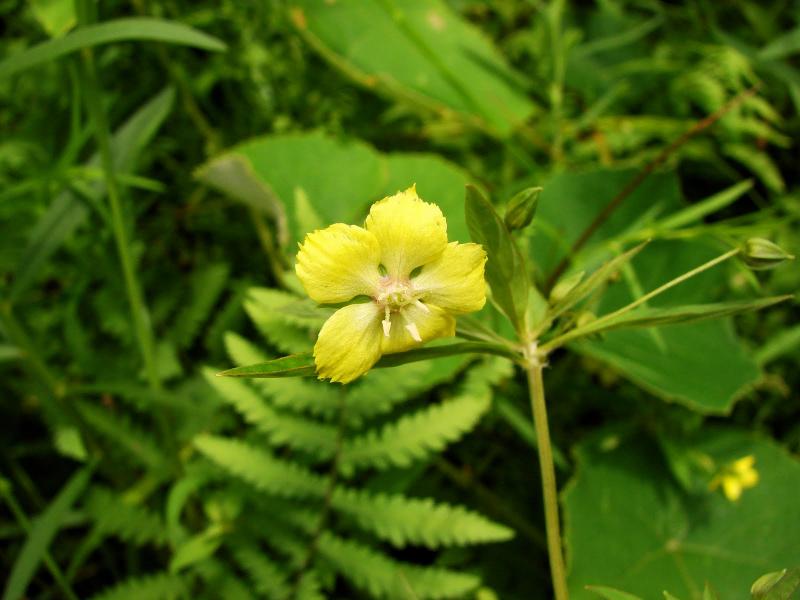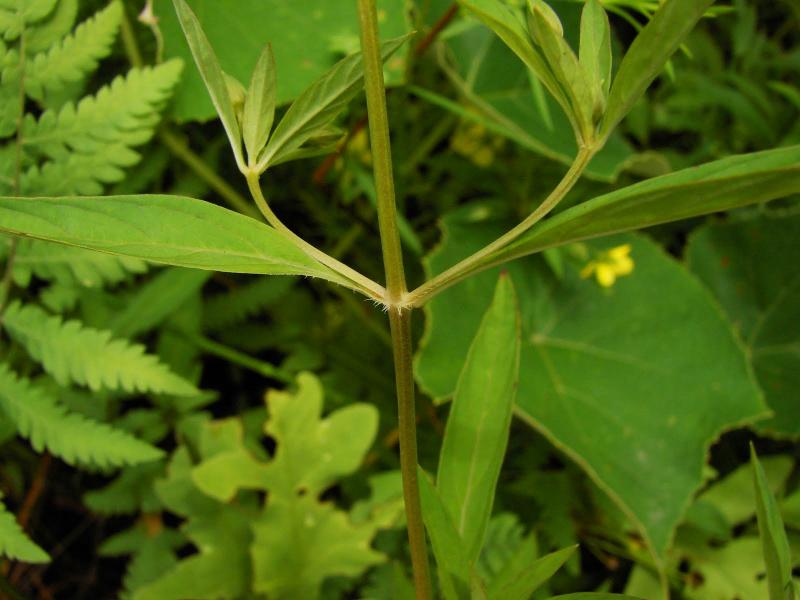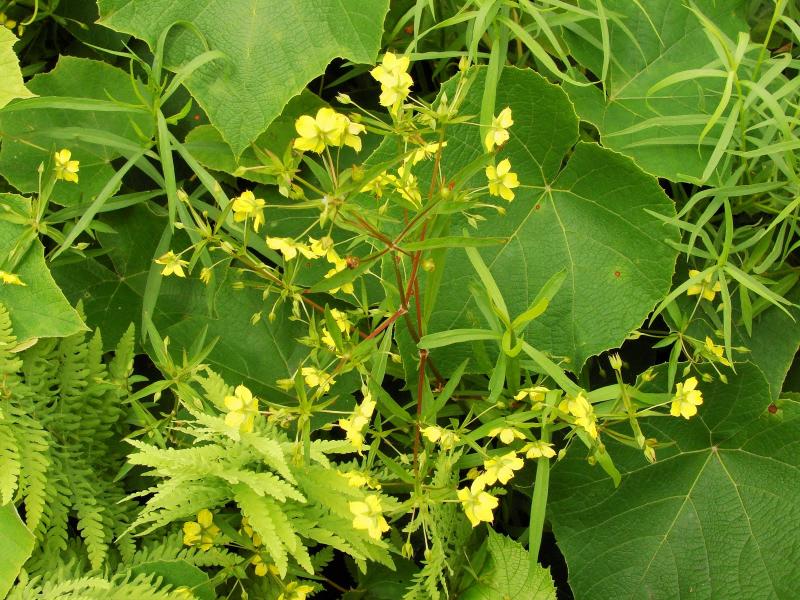Lowland Loosestrife
Lysimachia hybrida Michx.
- Class
- Dicotyledoneae (Dicots)
- Family
- Primulaceae (Primrose Family)
- State Protection
- Endangered
Listed as Endangered by New York State: in imminent danger of extirpation in New York. For animals, taking, importation, transportation, or possession is prohibited, except under license or permit. For plants, removal or damage without the consent of the landowner is prohibited.
- Federal Protection
- Not Listed
- State Conservation Status Rank
- S1
Critically Imperiled in New York - Especially vulnerable to disappearing from New York due to extreme rarity or other factors; typically 5 or fewer populations or locations in New York, very few individuals, very restricted range, very few remaining acres (or miles of stream), and/or very steep declines.
- Global Conservation Status Rank
- G5
Secure globally - Common in the world; widespread and abundant (but may be rare in some parts of its range).
Summary
Did you know?
This species is not really a hybrid of two other species but due to a confusion of specimens was named that way by the French botanist Andre Michaux (Fernald 1950).
State Ranking Justification
There are eight existing populations but most of them are small, with fewer than 50 plants. There are also 17 historical populations known from the late 1800s through the 1960s that need to be rechecked although three of these populations no longer exist because their habitat has been destroyed.
Short-term Trends
There has not been enough recent survey work to determine short-term trends. Some populations were so small they may now be extirpated.
Long-term Trends
The long-term trend is apparently negative. This plant has always been rare in New York, but the number of populations is still declining.
Conservation and Management
Threats
One population may be threatened by trampling or possibly by off-road vehicles. Succession and over visitation threatened another population.
Conservation Strategies and Management Practices
Establish wetland buffers to preserve hydrology and to prevent direct disturbance and the introduction and spread of wetland invasive species.
Research Needs
Research is needed into the specific habitat preferences of these plants. They occur in seemingly common habitat and more information is needed in order to prioritize areas to survey. Propagation studies could be done to see if populations can be augmented.
Habitat
Habitat
On Long Island it grows in open wet depressions in maritime shrubland and richer deciduous woodlands. It can be associated with other woodland wildflowers or scattered shrubs. Along Lake Champlain it grows in shallow emergent marshes that are associated with larger swamps including silver maple swamps (New York Natural Heritage Program 2012). Marshes, wet meadows, wet depressions, hammocks, swamps, stream banks (FNA Moist ground (Voss 1996). Sloughs, wet woods, and wet prairies (Gleason and Cronquist 1991). Swamps and wet shores (Fernald 1970).
Associated Ecological Communities
- Coastal plain pond shore*
(guide)
The gently sloping shore of a coastal plain pond with seasonally and annually fluctuating water levels. Plants growing on the pond shore vary with water levels. In dry years when water levels are low there is often a dense growth of annual sedges, grasses, and herbs. Submerged and floating-leaved aquatic plants, such as fragrant waterlily and pondweeds, may become "stranded" on the exposed shore. In wet years when the water level is high only a few emergents and floating-leaved aquatics may be noticeable. T
- Deep emergent marsh
(guide)
A marsh community flooded by waters that are not subject to violent wave action. Water depths can range from 6 in to 6.6 ft (15 cm to 2 m). Water levels may fluctuate seasonally, but the substrate is rarely dry, and there is usually standing water in the fall.
- Freshwater tidal marsh*
(guide)
A marsh community that occurs in shallow bays, shoals, and at the mouth of tributaries of large tidal river systems, where the water is usually fresh (salinity less than 0.5 ppt), and less than 2 m (6 ft) deep at high tide. Typically there are two zones in a freshwater tidal marsh: a low-elevation area dominated by short, broadleaf emergents bordering mudflats or open water, and a slightly higher-elevation area dominated by tall grass-like plants.
- Maritime shrubland
(guide)
A shrubland community that occurs on dry seaside bluffs and headlands that are exposed to offshore winds and salt spray.
- Sedge meadow*
(guide)
A wet meadow community that has organic soils (muck or fibrous peat). Soils are permanently saturated and seasonally flooded. The dominant herbs must be members of the sedge family, typically of the genus Carex.
- Shallow emergent marsh
(guide)
A marsh meadow community that occurs on soils that are permanently saturated and seasonally flooded. This marsh is better drained than a deep emergent marsh; water depths may range from 6 in to 3.3 ft (15 cm to 1 m) during flood stages, but the water level usually drops by mid to late summer and the soil is exposed during an average year.
- Silver maple-ash swamp
(guide)
A hardwood basin swamp that typically occurs in poorly-drained depressions or along the borders of large lakes, and less frequently in poorly drained soils along rivers. These sites are characterized by uniformly wet conditions with minimal seasonal fluctuations in water levels. The dominant trees are usually silver maple and green ash.
* probable association but not confirmed.
Associated Species
- Artemisia vulgaris (mugwort)
- Carex lurida (sallow sedge)
- Cornus sericea (red-osier dogwood)
- Euthamia caroliniana (slender flat-topped-goldenrod)
- Euthamia graminifolia (common flat-topped-goldenrod)
- Ilex verticillata (common winterberry)
- Lycopus uniflorus (northern bugleweed, northern water-horehound)
- Lysimachia terrestris (swamp-candles)
- Lythrum salicaria (purple loosestrife)
- Panicum virgatum (switch grass)
- Polygonum spp.
- Populus deltoides
- Salx spp.
- Scutellaria galericulata (marsh skull-cap)
- Sium suave (hemlock water-parsnip)
- Solidago
- Spartina pectinata (prairie cord grass)
- Thelypteris palustris
- Triadenum virginicum
- Vaccinium corymbosum (highbush blueberry)
- Vitis labrusca (fox grape)
Range
New York State Distribution
This herb is most common from Clinton county in northeastern New York, south to New York City and eastern Long Island. There is one historical record farther west in Oneida County. It is currently known on Long Island and along the shores of Lake Champlain.
Global Distribution
Lysimachia hybrida is widely distributed in the eastern U.S. and adjacent Canada. It is absent only from Ohio east of the Mississippi, and from nine states west of it. It is considered critically imperiled in New York, Vermont, Pennsylvania and Ontario.
Identification Comments
General Description
Lowland yellow loosestrife grows erect from a short rhizome to about 1 meter tall. It has many lateral branches which are longer than the leaves below them. The main leaves are narrowly oblong to lance-shaped, 4-10 cm long to 1-2 cm wide. The petiole is ciliate on the lower half but sometimes has cilia scattered in the upper half. The flowers are on long peduncles and the yellow petals are 6-10 mm long and 10 mm wide with long pointed tips. The flowers usually face out or down (Gleason and Cronquist 1991).
Best Life Stage for Proper Identification
It is easiest to see this plant when it is in flower but it can be identified just by observing the leaves.
Similar Species
Lysimachia ciliata, fringed loosestrife, is much more common and looks very similar but it has long slender rhizomes and the leaf petiole is prominently ciliate throughout its entire length (Gleason and Cronquist 1991).
Best Time to See
Lowland Yellow Loosestrife flowers from July through August, and the fruits may persist until the first frost.
- Vegetative
- Flowering
- Fruiting
The time of year you would expect to find Lowland Loosestrife vegetative, flowering, and fruiting in New York.
Lowland Loosestrife Images
Taxonomy
Lowland Loosestrife
Lysimachia hybrida Michx.
- Kingdom Plantae
- Phylum Anthophyta
- Class Dicotyledoneae
(Dicots)
- Order Primulales
- Family Primulaceae (Primrose Family)
- Order Primulales
- Class Dicotyledoneae
(Dicots)
- Phylum Anthophyta
Additional Common Names
- Loosestrife
- Lowland Yellow Loosestrife
Synonyms
- Lysimachia lanceolata Walt. [Misapplied to some New York specimens.]
- Lysimachia lanceolata ssp. hybrida (Michx.) J.D. Ray
- Lysimachia lanceolata var. hybrida (Michx.) A. Gray
- Steironema hybridum (Michaux) Rafinesque ex B.D. Jackson
- Steironema lanceolatum var. hybridum (Michx.) Gray
Additional Resources
Best Identification Reference
Gleason, Henry A. and A. Cronquist. 1991. Manual of Vascular Plants of Northeastern United States and Adjacent Canada. The New York Botanical Garden, Bronx, New York. 910 pp.
Other References
Fernald, M.L. 1950. Gray's manual of botany. 8th edition. D. Van Nostrand, New York. 1632 pp.
Holmgren, Noel. 1998. The Illustrated Companion to Gleason and Cronquist's Manual. Illustrations of the Vascular Plants of Northeastern United States and Adjacent Canada. The New York Botanical Garden, Bronx, New York.
Mitchell, Richard S. and Gordon C. Tucker. 1997. Revised Checklist of New York State Plants. Contributions to a Flora of New York State. Checklist IV. Bulletin No. 490. New York State Museum. Albany, NY. 400 pp.
New York Natural Heritage Program. 2010. Biotics database. New York Natural Heritage Program. New York State Department of Environmental Conservation. Albany, NY.
New York Natural Heritage Program. 2024. New York Natural Heritage Program Databases. Albany, NY.
Reschke, Carol. 1990. Ecological communities of New York State. New York Natural Heritage Program, New York State Department of Environmental Conservation. Latham, NY. 96 pp. plus xi.
Voss, Edward G. 1996. Michigan Flora Part III. Dicots Concluded (Pyrolaceae - Compositae). Cranbrook Institute of Science Bulletin 61 and University of Michigan Herbarium. 622 pp.
Weldy, T. and D. Werier. 2010. New York flora atlas. [S.M. Landry, K.N. Campbell, and L.D. Mabe (original application development), Florida Center for Community Design and Research http://www.fccdr.usf.edu/. University of South Florida http://www.usf.edu/]. New York Flora Association http://newyork.plantatlas.usf.edu/, Albany, New York
Links
About This Guide
This guide was authored by: Richard M. Ring
Information for this guide was last updated on: September 6, 2012
Please cite this page as:
New York Natural Heritage Program. 2024.
Online Conservation Guide for
Lysimachia hybrida.
Available from: https://guides.nynhp.org/lowland-yellow-loosestrife/.
Accessed July 26, 2024.



